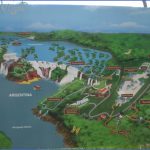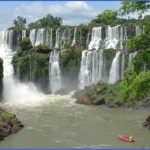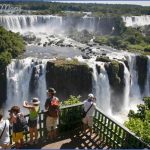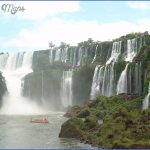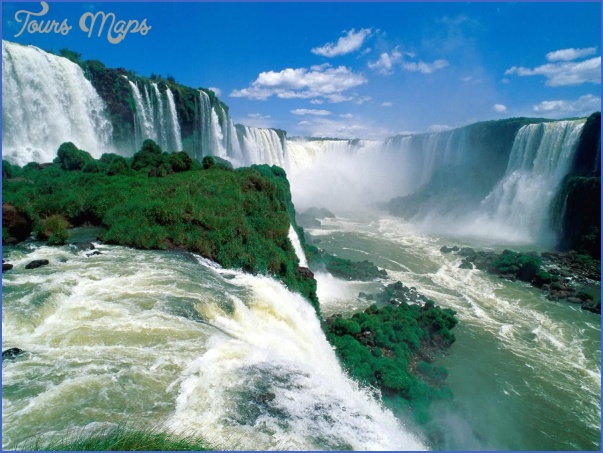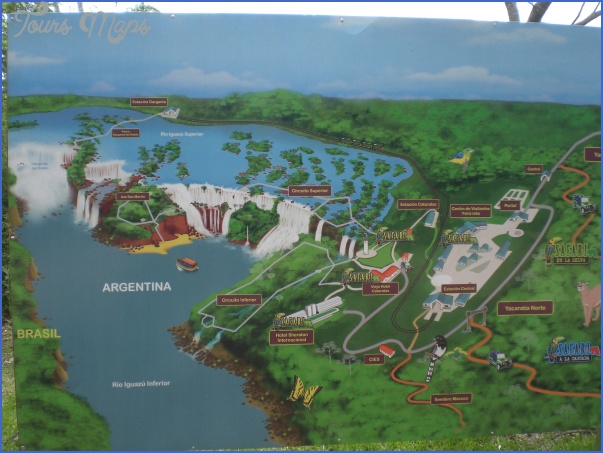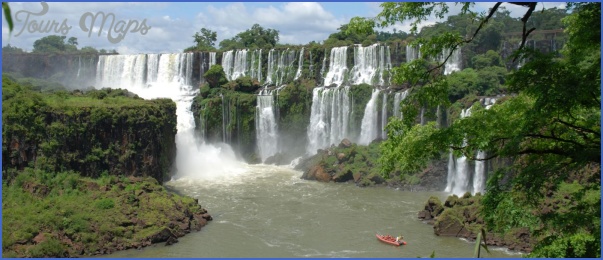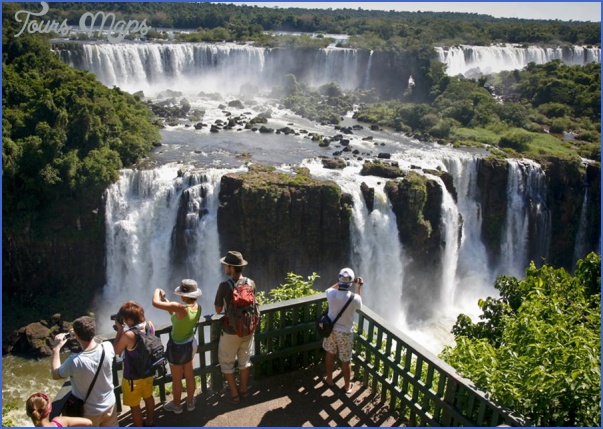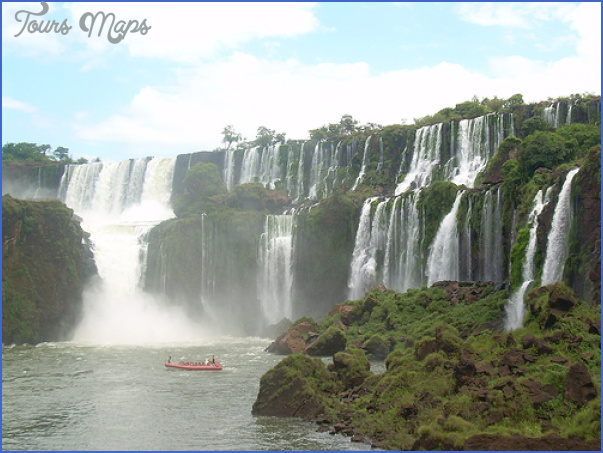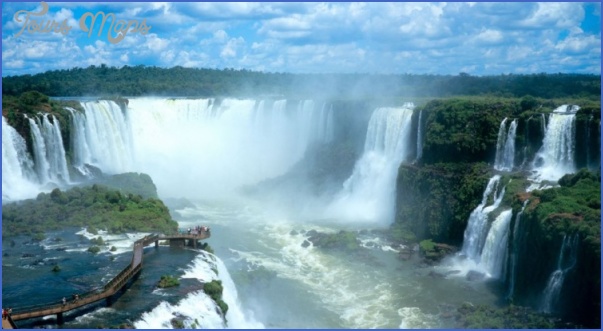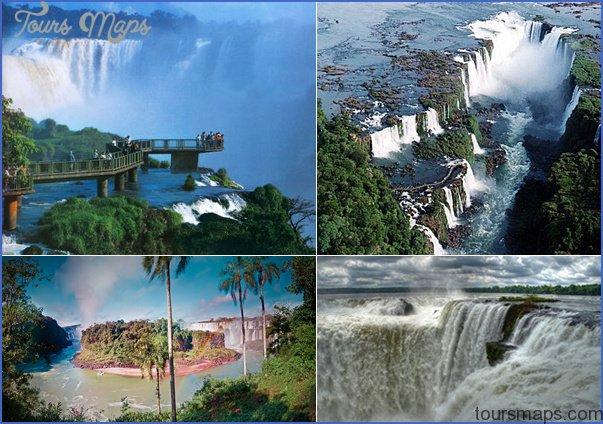At 67,620 hectares in size this park encompasses about two thirds of the falls themselves. Declared a World Heritage site in 1984 the park offers visitors numerous trails for enjoying a variety of views of the falls and coming into close contact with the region’s flora and fauna. A short walk from the park entrance is a small train named the Tren Ecologico de la Selva (ecological train of the jungle) which leads from the visitor’s center to various trailheads. Some trails are more physically demanding than others and handicapped accessible trails are clearly marked. If the water levels are low enough you can take a free boat ride across to Isla San Martin which offers additional trails, views of the waterfalls and swimming on a small beach near the foot of the falls. For most the highlight of the Argentine side is the Garganta del Diablo (Devil’s Throat) path – an elevated pathway that crosses wide stretches of the (deceptively tranquil looking) Iguazu River before leading out to the very mouth of the Garganta del Diablo waterfall. The massive amounts of water continuously spilling over the 700-meter long edge of this 82-meter high shoehorn shaped precipice are mesmerizing. For additional fees you can rappel, take a motor boat ride to the foot of the falls, or go on a moonlight tour of the falls (this option is available only five nights per month with advanced reservations). Shoes with good traction are recommended as walkways can get slippery and you should expect to get moderately soaked by the waterfall spray. Tel: From Paraguay: +54 3757491469, from Argentina: 0800 266 IGUAZU (4482), www.iguazuargentina.com, Entrance fee for non-Mercosur foreigners is 85 Argentine pesos with special discounts available for two day
visits (note you can only pay for the park entrance with Argentine pesos); hours: 6am to 6pm Getting There
Taxis from the Ciudad del Este bus terminal to Puerto Iguazu are about Gs. 130,000 and to the Argentine falls are approximately Gs. 180,000.
By Bus
In order to visit the falls by bus you must first make your way to the Puerto Iguazu bus terminal from which there are regular buses to the falls.
The bright yellow El Practico bus runs from 6am to 6pm between the Ciudad del Este and Puerto Iguazu bus terminals bypassing Brazilian immigration completely (an good option for those without Brazilian visas). Buses depart every forty minutes until about 3:30pm after which there are no buses until 6:00pm. Service is not as frequent on Sundays so it is best to get an early start. If you catch the bus at the bus terminal you will need to stop at Paraguayan immigration to get stamped out (be sure to ask the driver to let you off as most riders do not need to stop here). Hold on to your ticket – once you have obtained your stamp you can use your ticket to hop on the next El Practico (if you are already downtown it is unnecessary to double back to the bus terminal – simply walk to the bridge and catch the bus after getting stamped out). Tickets cost Gs. 8,000 (which can also be paid in Argentine pesos). Another option is the Crucero del Norte bus (also yellow) with “Puerto Iguazu/Argentina on the front which can also be boarded just past immigration controls. Tickets cost Gs. 10,000 (can be paid in Argentine pesos). The first bus leaves the Ciudad del Este bus terminal at 8:20am (arriving at the border between fifteen and forty minutes later depending on traffic) and continue to run hourly throughout the day with the last bus departing from Puerto Iguazu at 5:45pm and from Ciudad del Este at 7pm
From the Puerto Iguazu bus terminal, yellow buses marked Cataratas/Waterfalls will drop you off at the entrance to the park. The seventeen-kilometer trip takes approximately twenty minutes. Buses leave from the terminal every half hour starting at 7:10am till 7:40pm and return from the park every half hour starting at 7:45am and ending at 8:15pm
By Ferry
Another option is to reach the falls by ferry, which is ideal for those who are skittish about crossing through Brazil due to visa issues. The ferry departs hourly from the Puerto Hito Tres Fronteras in Presidente Franco on the Paraguayan side of the Parana River and docks at the port of Puerto Iguazu. The journey along the triple border between Argentina, Paraguay and Brazil formed by the meeting point of the Iguazu and Parana Rivers (twenty-three kilometers downriver from Iguazu Falls) is very enjoyable and takes about fifteen minutes. Depending on the day, the ferry includes several minivans packed to capacity with contraband goods such as beer and produce from Argentina. Tel: +54 3 757 – 422845 (in Argentina), the fee is Gs. 5,000 per person and Gs. 20,000 per vehicle, departures every 45 minutes Mon-Fri 8:30am-5:15pm from Presidente Franco and 8am-5:30pm from Puerto Iguazu. Future plans for bus service between Ciudad del Este and Puerto Iguazu using the ferry are in the works. Immigration officials can help arrange for taxis in to town on either side. Taxis to Puerto Hito Tres Fronteras should run about Gs. 50,000from the Ciudad del Este bus terminal. The Matiuaud Directo Franco bus can be caught along Avenida Pioneros del Este and will drop you off about ten blocks from the dock (ask to go to el hito). However, the latter option is not recommended as the area is very desolate and not safe for walking.
Border Control Issues
Because Brazil requires visas for American tourists many choose to visit the Argentine side of the falls. Although in order to reach the Argentine side of the falls from Ciudad del Este one must pass through Brazil, there are options for tourists without Brazilian visas. The first is to take the El Practico bus which runs between the Ciudad del Este and Puerto Iguazu, Argentina bus terminals without stopping for Brazilian immigration controls (see following section). The other is to take the ferry which runs between the ports of Presidente Franco and Puerto Iguazu.
Those joining private tours may find their drivers are able to breeze past immigration controls in Brazil and Paraguay altogether. Be aware that it is your responsibility to make sure you are properly stamped into and out of each country. A failure to do so could result in a fine the when exiting Paraguay or Brazil later on. Insist that your driver or guide allow you to be stamped in and out of each country. Most are used to dealing with Mercosur members who do not need stamps.
Parque Nacional Iguazu – Argentina Photo Gallery
Maybe You Like Them Too
- The Best Cities To Visit in The World
- World’s 10 Best Places To Visit
- Coolest Countries in the World to Visit
- Travel to Santorini, Greece
- Map of Barbados – Holiday in Barbados


